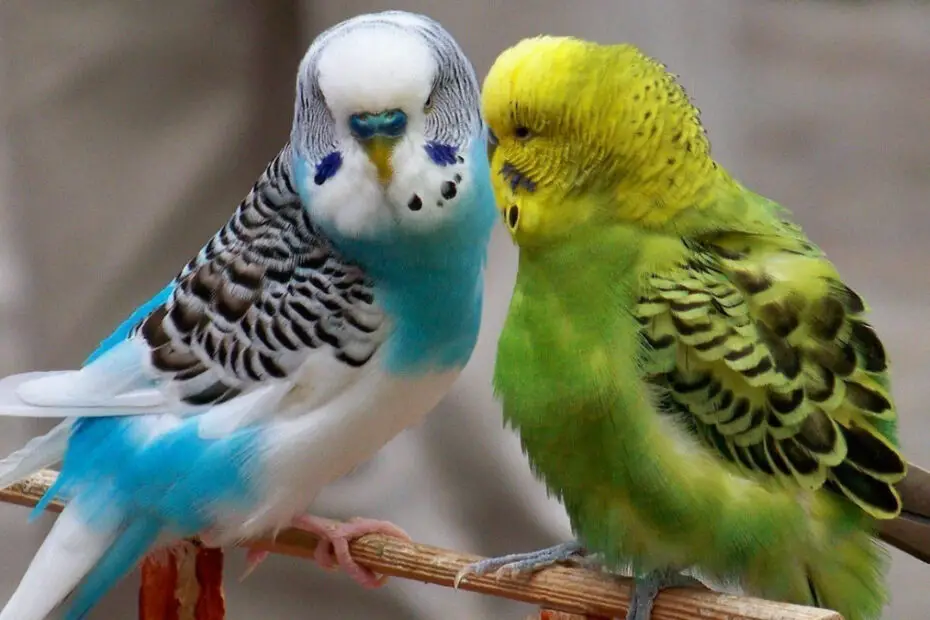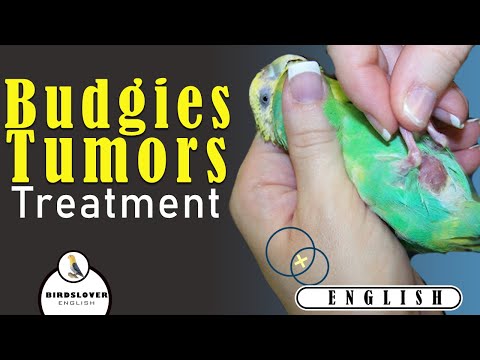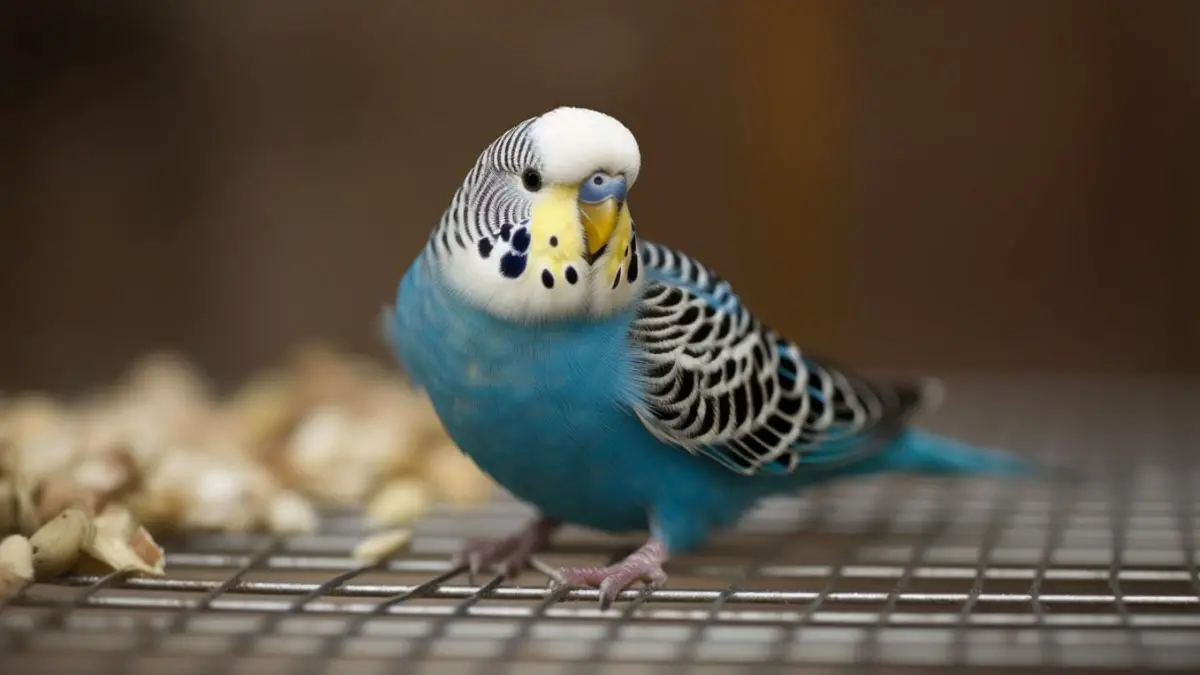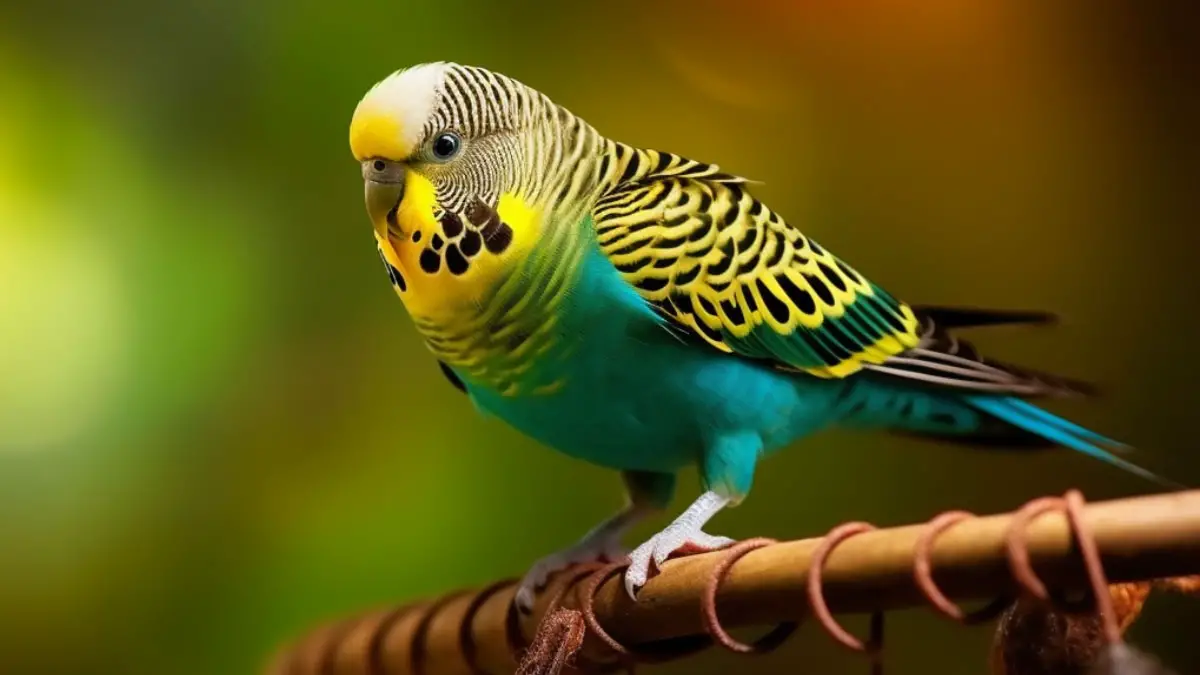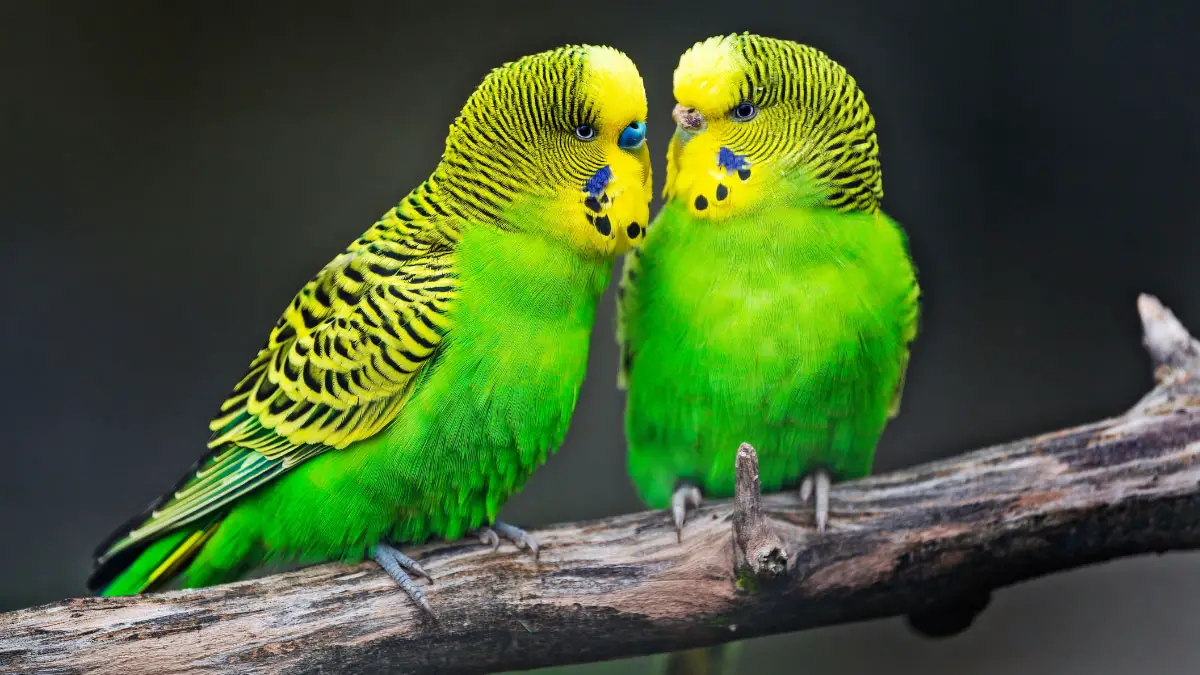If any cell of budgies keeps multiplying or growing without proper DNA control, it will result in budgie cancer. If you have any pet budgie, you need to examine it regularly to detect any unusual mass growth. Besides, you need to visit the veterinarian frequently to detect any internal tumors.
But how long can a budgie live with a tumor? It will depend on the type, location, and stage of the bird’s tumor. In minor cases, it may live up to 6-18 months without any surgery. But in critical cases, the tumor will be incurable and will die soon.
Throughout this article, we will enlighten you about the symptoms, causes and treatment of budgie tumors. You will also learn about their life expectancy and euthanization here. Let’s go through the article.
Causes of Tumors in Budgies
Normally, cell divisions of each cell stop after dividing for a certain time. But when the neurological and endocrine regulations over a cell division become imbalanced, the cell will keep dividing chaotically. As a result, the tumor will form in Budgie’s body.
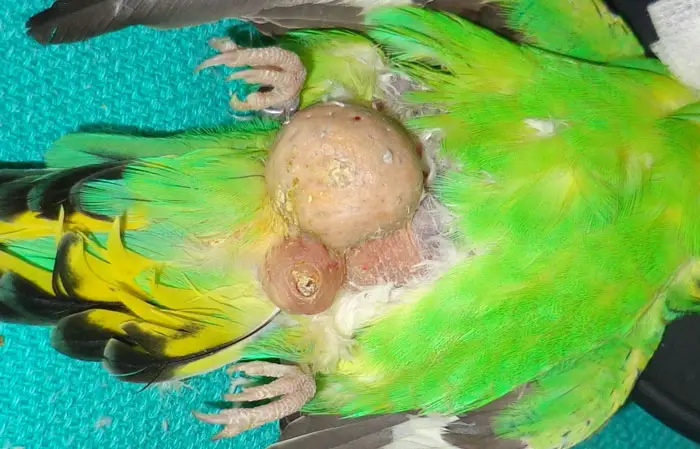
Here are several common causes of tumor of budgies:
Genetic Predisposition To Tumours
DNA monitors the cell division of the body. If any DNA mutation causes an imbalance in cell division, the mutated gene can transfer from generation to generation.
If the bird gets the mutated DNA from its ancestors, there is a high chance that it will also suffer from the tumor.
Exposure To Environmental Toxins
If there is any increase in budgies’ diagnosing cancers and tumors, this indicates the increase in toxins in the environment. Many pieces of research showed that DDT could damage the DNA with its mitogenic activity leading to hepatic tumors.
Moreover, this bird is also very sensitive to tobacco smoke. Smoking around this bird can lead it to suffer from a fatal lung tumor or cancer.
Poor Diet And Nutrition
Budgie health significantly depends on diet and nutrition. Thus, an improper diet can lead to vitamin A or calcium deficiency. Also, a poor diet consisting only of seeds can cause excessive fat gain.
In the wild, the bird will get a lot of physical exercise to control its body fat. But in captivity, there is less scope for physical exercise. Thus, all-seed diets may lead them to fatty tumors.
Viral Infections
Various viral avian diseases and infections can build up tumor cells in the bird’s body. For example, papillomatous diseases with the herpes virus can cause pancreatic tumors and cancer.
Trauma And Injury
After any accident, tumors of soft tissues can arise in the budgies. Generally, the cell injury will lead to inflammation and tissue regeneration. If the repetitive injury keeps triggering this inflammation, this wound-healing procedure may turn into a tumor or cancer.
Symptoms And Diagnosis Of Budgie Tumors
If your pet bird has a tumor, it will show some common symptoms regardless of the type of tumor. Yet, for confirmation, it’s better to visit a vet for a proper diagnostic test on your budgie. Let’s go through the details:
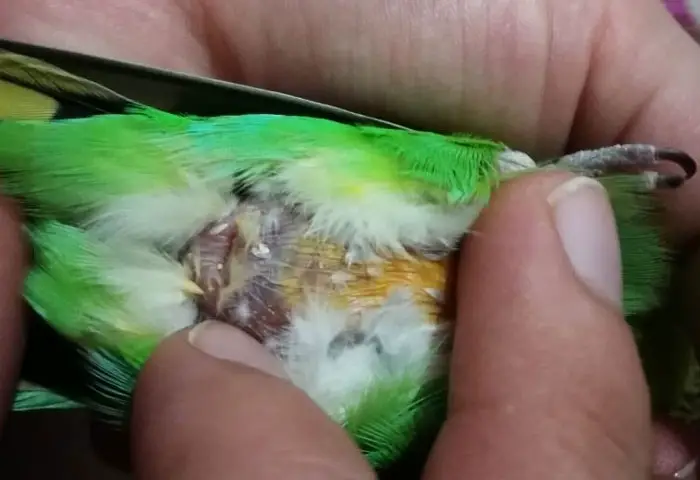
Common Symptoms Of Tumors In Budgies
Here are several common tumor symptoms in budgies:
- A large bulge or mass will form beneath the skin of your bird
- It will start losing its playfulness and get irritated easily
- Your bird will stand on one foot
- It will eat less than usual
- The bird will start losing weight
- Excessive urination
Diagnostic Tests To Detect Tumors In Budgies
Diagnosing the tumor mostly depends on the budgie anatomy. The anatomy’s discipline can be microscope, macroscopic, or gross anatomy. Gross anatomy will include the budgies’ superficial anatomy that you can examine without any instruments.
But the other two will refer to examining the internal anatomy of the bird. Also, these will require the involvement of various instruments.
Here are a few examples of diagnostic tests for detecting the existence of tumors in your bird:
- You can detect the presence of external tumors through regular physical examination. If you feel or see any unusual lump on the bird’s body, you need to visit a vet shortly
- Evaluating the biochemical profile and haemogram of the bird
- Using elevated serum enzymes for identifying internal tumors
- When a tumor is close to any bone, an X-Ray or radiography can help to detect that tumor
- Sometimes the vets take a slight mass from the tumor and perform a biopsy to know whether the budgie tumors are cancerous or not
Types Of Tumors Found In Budgies
The tumor types will depend on the location of the tumor. Generally, these tumors can be both cancerous and non-cancerous. Some tumors are not that serious, but some can be quite fatal for the budgies. For examples:
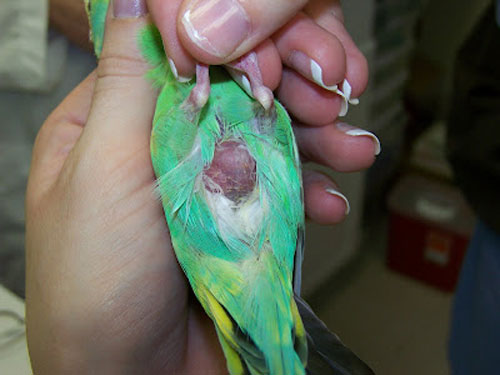
- Lipomas or liposarcomas: Lipomas and liposarcomas are benign and malignant tumors of lipoblasts. They are normally located near the breast bones.
- Pituitary adenomas: It is generally the tumor of the nervous system. Eventually, this tumor can cause muscle spasms or seizures.
- Lymphoma: This type of tumor is cancerous and occurs in the liver, kidneys, and spleens.
- Xanthomas: It’s not a real tumor and consists of a yellow-fatty mass. Generally, this will occur under the bird’s skin near the wing tips and chest areas.
- Fibroma and fibrosarcoma: They are benign and malignant tumors of fibrous connective and fibroblast tissues, respectively.
Treatment Options For Budgie Tumors
For treatment, taking your bird to veterinary hospitals is preferable over consulting any local veterinary quacks. In the vet hospitals, there will be skilled and certified vets. Also, there will be numerous facilities and amenities which will ensure better treatment and recovery of your bird.
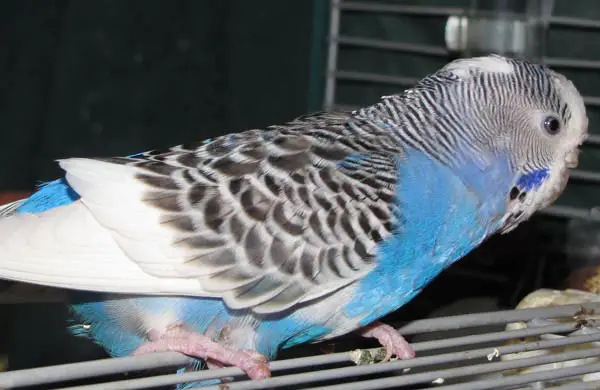
Let’s know about some treatment options for tumors of your budgie:
Surgery To Remove Tumors
Generally, doctors will perform surgery on the bird’s tumor if the tumor is benign or small-malignant. During surgery, they generally remove at least .5 cm of normal cells around the tumor cells along with the tumor.
In the case of a malignant tumor, amputations are the best method for preventing the further spread or comeback of the tumor. But sometimes, the size of the bird and the tumor location may restrict the application of surgical removal methods.
Radiation Therapy
For superficial tumors, doctors use strontium-90 beta particles. If the tumor is located in the depth of the bird’s body, doctors use iridium-192 to concentrate the irradiation on the tumor cell.
Sometimes, the irradiation can cause the death of the normal cells along with the tumor cells.
Chemotherapy
Chemotherapy can also be an option for treating the bird’s tumor. Generally, corticosteroids are the most common chemotherapeutic agents for the bird. But in most cases, the budgie can get an adverse reaction from the chemotherapy.
Palliative Care To Alleviate Symptoms
Generally, the budgie species is most prone to tumors among all types of pet birds. This species is quite small and will weigh around 30-40 grams. Due to its low weight, this bird species are vulnerable to blood loss
Thus, if the tumor gets large, removal of that mass can be risky and will cause significant blood loss. In this type of case, the vet prefers to give the bird medication to reduce its pain.
Sometimes, when it becomes too large that it’s suppressing the blood or oxygen flow, the doctors decide to cut a part of the whole tumor. This will reduce the tumor size to a moderate level, and the bird can live a little longer with appropriate budgie care.
Hospice Care For End-of-life Comfort
Hospice care generally refers to providing your bird with comforting care instead of any curative treatment. For examples:
- Keep your tone soft while talking with your pet bird
- Avoid making loud noises around its cage
- While taking it out of the cage, hold it in a snuggly and warm blanket
- It will feel severely cold during this period, so you need to cover its cage partially
Check this Youtube video to understand the budgie’s tumor treatment methods better:
Life Expectancy Of Budgies With Tumors
This will depend on 3 factors:
- Types Of Tumor: Two significant tumor types are benign and malignant. Generally, the former poses less risk than the latter one. Your bird can live for up to 6- 24 months with benign tumors.
But, the malignant tumor will keep spreading without surgical removal. Thus, in this case, your bird may die within 2-3 months.
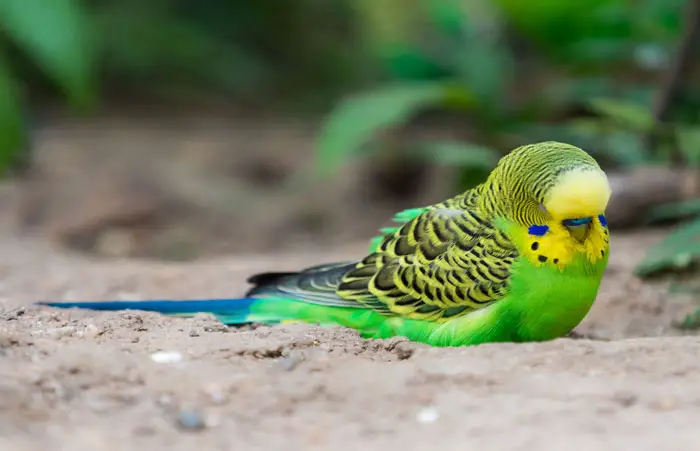
- Location Of Tumor: External tumors are easy to remove through the operation. But if the location of the tumor is near any crucial body part of the bird which has a significant blood supply, it’s difficult to remove.
- Stage Of The Tumor: The surgical removal of avian tumors is easier when the tumor is small and at the initial stage. If the tumor gets bigger or spreads much, there is less chance of curing that.
Prognosis For Different Types Of Tumors
If your bird has a benign tumor that is external, then it’s curable. When the tumor size is small, it can get cured with proper medication. But if the size is slightly bigger, the vet will need to remove the tumor surgery.
In case the tumor is malignant and internal, it’s quite tough for the vet to perform surgery. Sometimes, this type of tumor can even cause avian cancer.
When this tumor is in its initial stage, the vet may cut out the tumor cell with some surrounding cells. Also, sometimes, this type of tumor may require amputation of any body parts.
Quality Of Life Considerations For Budgies With Tumors
When the tumor is located in any complex position, there is a high chance that the operation won’t be successful. Because during surgery, the bird may die due to excessive blood loss or the life after surgery may become too painful for it.
There are also many cases where the budgie lived 6-7 years more after the tumor surgery. The success rate will depend on the quality of life of your pet. Thus, before deciding on surgery, consider your bird’s conditions, complexity, and tumor stage.
Caring For Budgies With Tumors
Generally, tumors will hamper the comfort and daily activities of your pet bird. That’s why intensive caring for budgies with tumors is necessary to make its life slightly less complex. Here are some ways for that:
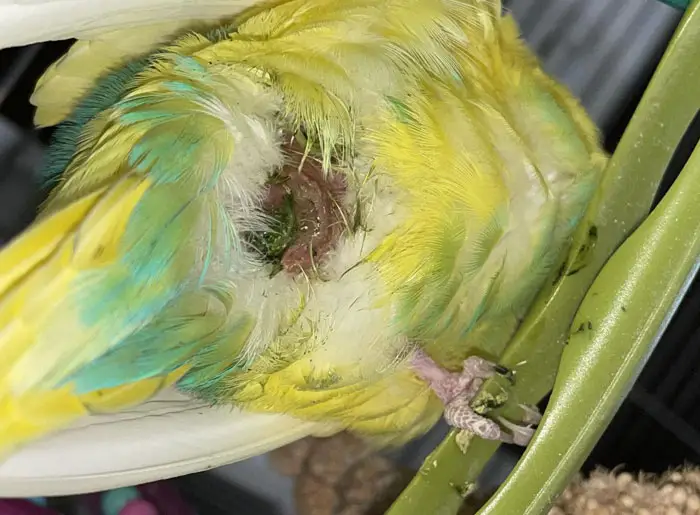
Providing Supportive Care
Here are several tips for providing supportive care for budgies with tumors:
- Provide healthier and balanced food to your pet bird to improve its overall immune system
- Feed your bird anti-inflammatory and antibiotic medicine that the vet will prescribe
- You can offer your bird different types of supplements of vitamin A and its precursors
- Use a heating pad to keep your bird comfortable and warm
- If it can’t eat by itself, you need to start hand-feeding it
Dietary Changes
Alongside the supportive care, you also need to ensure a balanced diet for your bird, such as:
- Instead of providing them with a single-seed diet, offer them a seed mix of oats, safflower, flax, canary seed, etc.
- You can also offer your bird a food mixture of sprouted seeds, vegetables, and egg foods
- Sometimes, you can treat them with little pieces of fruit
- Offer your bird different types of pellets
Monitoring For Changes In Tumor Size Or Behavior
Generally, the benign tumor doesn’t spread; but the malignant tumor will. Though the former doesn’t spread, its size will keep growing. Thus, you just need to keep monitoring if the size of the tumor is growing or if it’s spreading to other cells.
If the tumor condition gets worse, your bird will start showing changes in its behavior. Upon monitoring, you can make decisions like:
- When the tumor size gets bigger and causes difficulty in the bird’s movement, move it to a smaller cage
- If you find them struggling to climb up, rotate the cage slightly to remove its difficulty in climbing
Importance Of Regular Check-ups With A Veterinarian
Here is the importance of visiting a veterinarian regularly after the tumor diagnosis of your bird:
- With the tumor condition, a vet may suggest a change in your pet’s diet to ensure better budgie nutrition
- Initially, when a benign tumor is tiny, it doesn’t pose any risk. But when the tumor gets bigger, it may require surgery. A vet can tell when the surgery is necessary
- Also, a bird with a tumor will need proper avian veterinary care for a less painful life
When to Consider Euthanasia
Sometimes, you may need to decide to euthanize your pet budgie to end the tremendous pain that it’s facing. Here are some considerations regarding this:
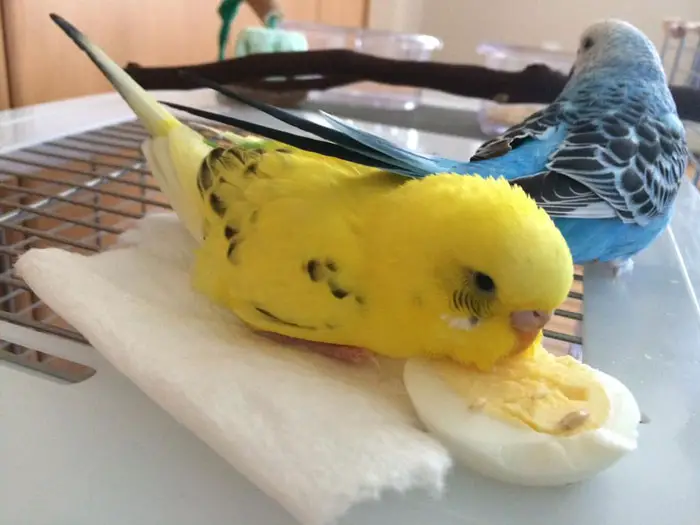
Signs That A Budgie’s Quality Of Life Is Declining
When the bird is severely sick and suffering, it will show some cues. By monitoring those signs, you can decide when to euthanize a budgie with a tumor. Those signs are:
- The bird becomes lethargic and refuses to move much
- It loses its appetite
- Sometimes, it may bob its tail continuously with puffed-up feathers
- Your pet bird keeps shaking or shivering constantly
- Vomiting with the sign of a jerking body
- Tumors become too large and hamper the balance or other activities of your bird
Ethical Considerations When Making End-of-life Decisions
When making end-of-life decisions, the most crucial ethical considerations are:
- You can only take the end-of-life care of your bird when the tumor is incurable, inoperable, and causing severe suffering to the bird
- There should be no pain associated with the euthanization process
- The process should be rapid and in the bird’s unconscious condition
- Before the euthanization, you should keep your bird calm, talk with it softly, pet it, and keep it hydrated
Importance Of Consulting With A Veterinarian
Though you can find numerous ways of euthanization, you must visit a veterinarian before euthanization. The reasons are:
- Those signs of declining life quality can be confusing. Thus, you need to confirm the bird’s health and tumor condition from the vet
- This euthanasia process requires a skilled person who has access to anesthetic and sedative drugs. A vet will be the most qualified person for that
- After checking the bird’s overall health conditions, a vet can decide well on the preferable way of euthanization
Conclusion
The tumor of budgies is curable if you can detect it in its early stage. Later the size can become too spread or larger to remove by surgery. In this article, we discussed: how long can a budgie live with a tumor.
If the tumor removal surgery becomes successful, the bird can live a long time. But in most cases, the tumor condition gets complex due to late diagnosis. Thus, instead of surgery, you should concentrate on making your bird happy and supporting it until its death.
